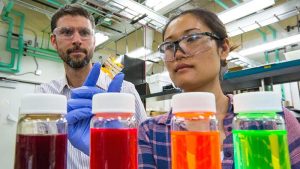
NREL senior scientist Joseph Luther and Dr. Erin Sanehira.
A collaboration between researchers at the University of Washington Department of Electrical Engineering (UW EE) and the Department of Energy’s National Renewable Energy Laboratory (NREL) yields a new world efficiency record for quantum dot solar cells at 13.4 percent.
Quantum dots are incredibly small electronic materials. Ranging from 3 to 20 nanometers in size, they are about one million times smaller than a raindrop. Because of their size, they possess advantageous optical properties. These properties make them valuable for photovoltaic use, or the process of converting light to electricity (i.e. material used in solar panels).
Researchers have been looking at quantum dots as a source of solar cells for nearly three decades. Their goal has centered around the concept of solar cell efficiency, which refers to the portion of energy in the form of sunlight that can be converted into electricity via photovoltaics. The initial quantum dot solar cells had an efficiency of 2.9 percent. Over the years, researchers have expanded this efficiency to 12 percent through a better understanding of the connectivity between individual quantum dots, better overall device structures and through the reduction of defects in lead sulfide quantum dots.

Professor Lih Lin
In a recent article, entitled “Enhanced mobility CsPbI3 quantum dot arrays for record-efficiency, high-voltage photovoltaic cells,” researchers reached a new record of 13.4 percent. The article, which was published in the October 17th issue of Science Advances, details the reason behind the higher efficiency. The latest advancement in quantum dot solar cells utilizes a new material – cesium lead triiodide (CsPbI3).
CsPbI3 produces an exceptionally large voltage at open circuit, meaning that is allows a higher portion of sunlight to reach lower layers when paired with the material’s bandgap. Voltage and the material’s bandgap are two important factors when achieving higher efficiency in a multijunction solar cell.
Multijunction solar cells use different semiconductor materials, which interface between multiple p-n junctions. In the latest advancement, CsPbI3 can be paired with cheap thin-film perovskite materials. The multijunction approach is often used for space applications, where high efficiency is more critical than the cost to make a solar module. The research team’s new finding can achieve a similar high efficiency as demonstrated for space solar cells. Built at lower costs than silicon technology, they are ideal for both terrestrial and space applications.
Former UW EE graduate student Erin Sanehira (Ph.D. ’17) received a NASA fellowship to work on the research while a student at UW EE. She is first author on the paper. Her advisor, Professor Lih Lin is a Co-PI on the work. For Sanehira, the work expands the potential applications for quantum dot solar cells – from Earth to space.
“Often, the materials used in space and rooftop applications are totally different,” Sanehira said in a recent article. “It is exciting to see possible configurations that could be used for both situations.”
Additional authors on the work include NREL researchers Ashley Marshall, Jeffrey Christians, Steven Harvey, Peter Ciesielski, Lance Wheeler, Philip Schulz, Matthew Beard and Co-PI Joseph Luther.
The NREL research was funded as part of the Center for Advanced Solar Photophysics (CASP) an Energy Frontier Research Center funded by the Office of Basic Energy Sciences with the Office of Science of the Department of Energy.

